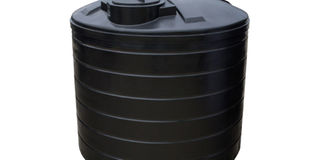What to consider when buying a water tank

What you need to know:
If you want to buy a water tank but are torn between buying plastic or stainless steel, here is a simple guide to help you decide on which one best suits your desired purpose
Water tanks are used to store and reserve water for both domestic and commercial purposes, making them essential for any property. Also, with our economy today, where everyone is looking for ways to minimise domestic bills, more people are buying water tanks to harvest rainwater, to use alongside piped water to reduce on the water bills.
Water tanks, are made out of many different materials, but the ones available on the Ugandan market, are mostly poly-plastic and steel water tanks.
If you want to buy a water tank but you are torn between buying plastic or stainless steel, here is a simple guide to help you decide on which one best suits your desired purpose, based on cost, capacity and location.
Advantages of steel tanks
Steel tanks, specifically stainless steel tanks are very durable. According to Aloysius Ntambi, the public relations officer at Steel and Tube Limited, a good quality stainless steel tank is timeless. “Since it is made out of stainless steel, it does not rust, can withstand all weather conditions, such as extreme hot or cold temperatures. Once it is properly installed at your property, be sure to have it until you get tired of it,” says Ntambi.
Another advantage with stainless steel water tanks is that they are heat resistant, protecting the stored water from sun rays. When sun rays penetrate into the water, they lead to the growth of algae, making the water unhealthy an unhygienic for domestic use.
“The water tank has a breather at the top which generated heat from within escapes. Steel tanks are in a variety of capacities, with the smallest having a water holding capacity of 60 litres, and the biggest 10000 litres,” he says.
Disadvantages
They may be abit more costly than plastic tanks.
A bad quality tank made out of steel is mostly likely to corrode.
Advantages
They are affordable and very accessible. Plastic as a material, is cheaper than, steel, plus the difference in manufacturing process, makes them more affordable. Plastic water tanks can be found in almost every suburb in Uganda.
A good quality plastic tank will have an expected life span of about 30 years. “One way to find out if a water tank is made of durable material, according to Hardik Dudhela, the sales manager at Crestanks Limited, is by pressing the surface inwards, to see if it is flexible.
“The plastic should be firm but flexible, so that, when water is poured into the tank the surface of the tank expands, if the plastic is hard and brittle, then the tank stands a chance of cracking or bursting,” says Dudhela.
Plastic water tanks have a variety of capacities, with the smallest being 50 litres and the biggest being 24000 litres making them very suitable for domestic and commercial use.
Disadvantages
Plastic tanks, particularly those that are darker in colour, are susceptible to Ultraviolet rays from the sun, which warms up the water. Warm water is the perfect breeding ground for algae.
Extreme heat leads to small portions of plastic melting into the water which makes it unsafe to drink. However, to avoid this, one should invest in a good quality water tank made from non-toxic plastic.
“Plastic tanks made from 100 percent food grade material are the most suitable for water storage, non-toxic food grade plastic material, protects the tank from UV rays from the sun, making the water safe for consumption,” says Dudhela.
Maintenance
Water tank cleaning is an essential part of water hygiene. Over time, dirt, dust, debris, mould and harmful bacteria can build up in the water tank. Regular cleaning will remove these from the system, ensuring it is clean, safe and compliant.
Stagnant, low circulation water sources can be a potential breeding ground for unwanted and harmful bacteria.
Care
Stagnation can be caused by many factors including under-utilising water, using an excessively large tank, and issues in your water system causing blockages or poor flow. These factors aside, there will always be some stagnation in water tanks. Therefore regular cleaning and disinfection is essential even if these risks are low.
Before you start the cleaning process, a pre-disinfection cleaning flush is required. The tank inlet must be isolated so that the tank can be drained and inspected. Any booster pumps associated with the system / tank should also be isolated from mains power supply.
Empty the tank then manually scrape clean all internal surfaces. All visible dirt and debris should be removed.




